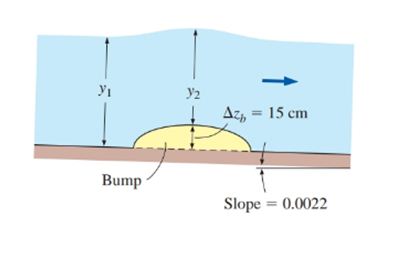
Consider uniform water flow in a wide channel made of unfinished concrete laid on a slope of 0.0022. Now water flows over a 15-cm-high bump. If the flow over the bump is exactly critical (Fr = 1), determine the flow rate and the flow depth over the bump per m width.

The flow rate.
The flow depth over the bump per
Answer to Problem 119P
The flow rate is
The flow depth is
Explanation of Solution
Given information:
The slope of the wide channel made of unfinished concrete is
The flow is steady and uniform, the channel is sufficiently wide so that the end effects are negligible, the frictional effects during the flow over the bump are negligible bottom slope is constant, roughness coefficient is constant along the channel, the width of the water channel is assumed to be
Write the expression for the flow rate for which the hydraulic radius is equal to the flow depth from the manning equation.
Here, the manning coefficient for an open channel of unfinished concrete is
Write the expression for the critical depth corresponding to the flow rate.
Here, the water flow rate through the channel per meter width is
Write the expression for the average flow velocity.
Write the expression for the specific energy before the bump.
Here, the average flow velocity is
Write the expression for the critical specific energy.
As, the critical specific energy is equal to the specific energy after the bump because the critical depth corresponding to the flow rate is equal to the depth of the flow after the bump.
Here, the critical depth of the flow is
Write the expression for the specific energy on the bump.
Here, the height of the bump is
Calculation:
Substitute
Substitute
Substitute
Substitute
Substitute
Substitute
By hit and trial method.
Substitute
Substitute
Conclusion:
The flow rate is
Want to see more full solutions like this?
Chapter 13 Solutions
Connect 1 Semester Access Card For Fluid Mechanics Fundamentals And Applications
- Water flows uniformly half-full in a 2-m-diameter circular channel that is laid on a grade of 1.5 m/km. If the channel is constructed of finished concrete, determine the flow rate of the water.arrow_forwardA rectangular channel with a bottom width of 7 m discharges water at a rate of 45 m3/s. Determine the flow depth below which the flow is supercritical.arrow_forwardWater is to be transported in a cast iron rectangular channel with a bottom width of 6 ft at a rate of 70 ft3/s. The terrain is such that the channel bottom drops 2.1 ft per 1000 ft length. Determine the minimum height of the channel under uniform-flow conditionsarrow_forward
- The flow rate of water in a 10-m-wide horizontal channel is being measured using a 1.3-m-high sharp-crested rectangular weir that spans across the channel. If the water depth upstream is 3.4 m, determine the flow rate of water.arrow_forwardConsider water flow through two identical channels with square flow sections of 4 m × 4 m. Now the two channels are combined, forming a 8-m-wide channel. The flow rate is adjusted so that the flow depth remains constant at 4 m. Determine the percent increase in flow rate as a result of combining the channels.arrow_forwardConsider uniform water flow in a wide rectangular channel with a depth of 2 m made of unfinished concrete laid on a slope of 0.0022. Determine the flow rate of water per meter width of channel. Now water flows over a 15-cm-high bump. If the water surface over the bump remains flat (no rise or drop), determine the change in discharge rate of water per meter width of the channel.arrow_forward
- Water flows in a 2-m-diameter finished concrete pipe so that it is completely full and the pressure is constant all along the pipe. If the slope is So= 0.005, determine the flowrate by using open channel flow methods.arrow_forwardA trapezoidal channel with a bottom width of 6 m, free surface width of 12 m, and flow depth of 1.6 m discharges water at a rate of 80 m3/s. If the surfaces of the channel are lined with asphalt (n = 0.016), determine the elevation drop of the channel per kilometer.arrow_forwardWater is flowing uniformly in a finished-concrete channel of trapezoidal cross section with a bottom width of 0.8 m, trapezoid angle of 50°, and a bottom angle of 0.4°. If the flow depth is measured to be 0.52 m, determine the flow rate of water through the channel.arrow_forward
- A 3ft-diameter semicircular channel have a flow rate of 90 ft3 /s when the channel is full, determine the Hydraulic Radius.arrow_forwardConsider water flow through a wide rectangular channel undergoing a hydraulic jump. Show that the ratio of the Froude numbers before and after the jump can be expressed in terms of flow depths y1 and y2 before and afterthe jump, respectively, as Fr1/Fr2 = √(y2/y1)3arrow_forwardThe flow rate of water in a 6-m-wide rectangular channel is to be measured using a 1.3-m-high sharp-crested rectangular weir that spans across the channel. If the head above the weir crest is 0.70 m upstream from the weir, determine the flow rate of water.arrow_forward
 Elements Of ElectromagneticsMechanical EngineeringISBN:9780190698614Author:Sadiku, Matthew N. O.Publisher:Oxford University Press
Elements Of ElectromagneticsMechanical EngineeringISBN:9780190698614Author:Sadiku, Matthew N. O.Publisher:Oxford University Press Mechanics of Materials (10th Edition)Mechanical EngineeringISBN:9780134319650Author:Russell C. HibbelerPublisher:PEARSON
Mechanics of Materials (10th Edition)Mechanical EngineeringISBN:9780134319650Author:Russell C. HibbelerPublisher:PEARSON Thermodynamics: An Engineering ApproachMechanical EngineeringISBN:9781259822674Author:Yunus A. Cengel Dr., Michael A. BolesPublisher:McGraw-Hill Education
Thermodynamics: An Engineering ApproachMechanical EngineeringISBN:9781259822674Author:Yunus A. Cengel Dr., Michael A. BolesPublisher:McGraw-Hill Education Control Systems EngineeringMechanical EngineeringISBN:9781118170519Author:Norman S. NisePublisher:WILEY
Control Systems EngineeringMechanical EngineeringISBN:9781118170519Author:Norman S. NisePublisher:WILEY Mechanics of Materials (MindTap Course List)Mechanical EngineeringISBN:9781337093347Author:Barry J. Goodno, James M. GerePublisher:Cengage Learning
Mechanics of Materials (MindTap Course List)Mechanical EngineeringISBN:9781337093347Author:Barry J. Goodno, James M. GerePublisher:Cengage Learning Engineering Mechanics: StaticsMechanical EngineeringISBN:9781118807330Author:James L. Meriam, L. G. Kraige, J. N. BoltonPublisher:WILEY
Engineering Mechanics: StaticsMechanical EngineeringISBN:9781118807330Author:James L. Meriam, L. G. Kraige, J. N. BoltonPublisher:WILEY





